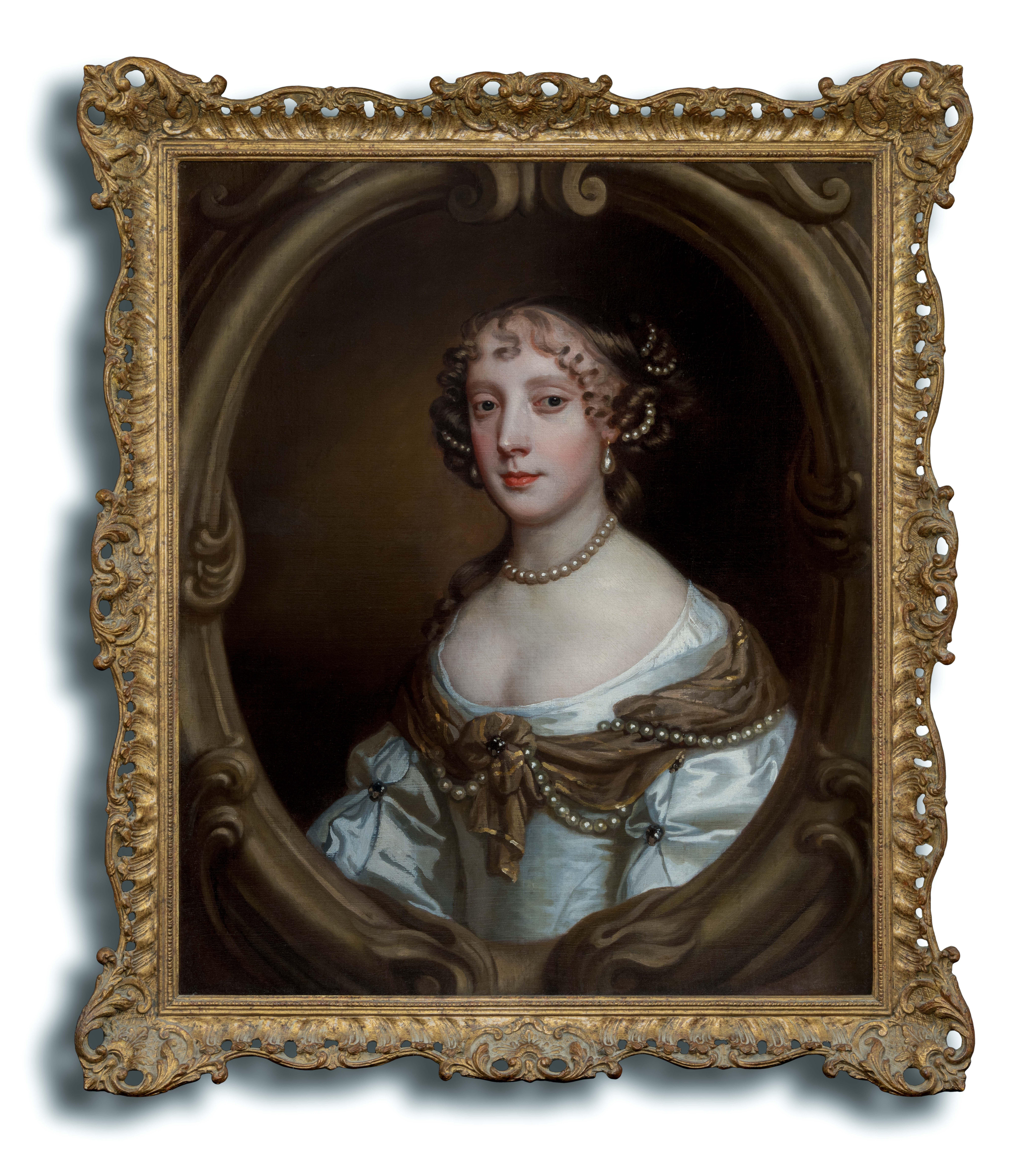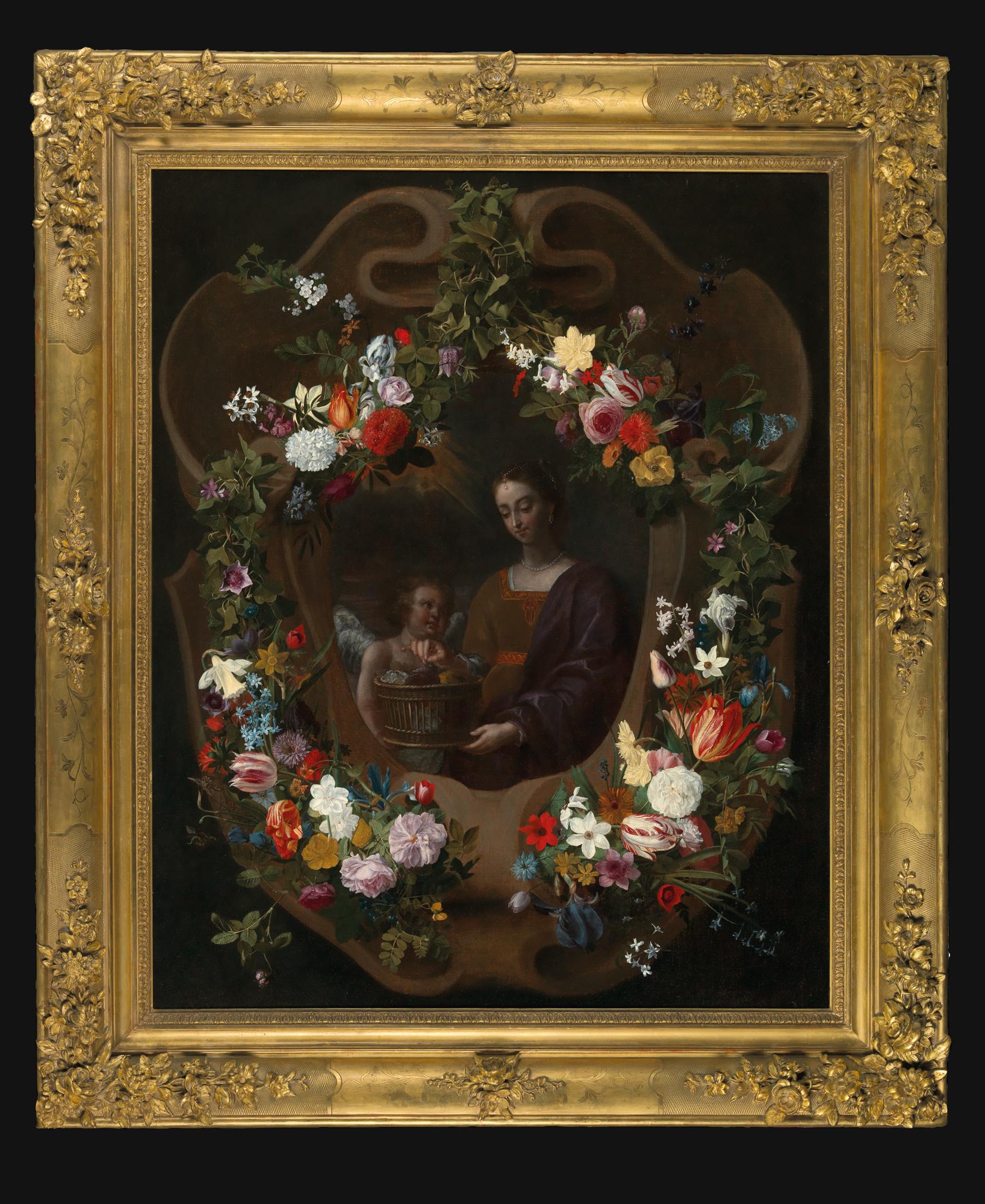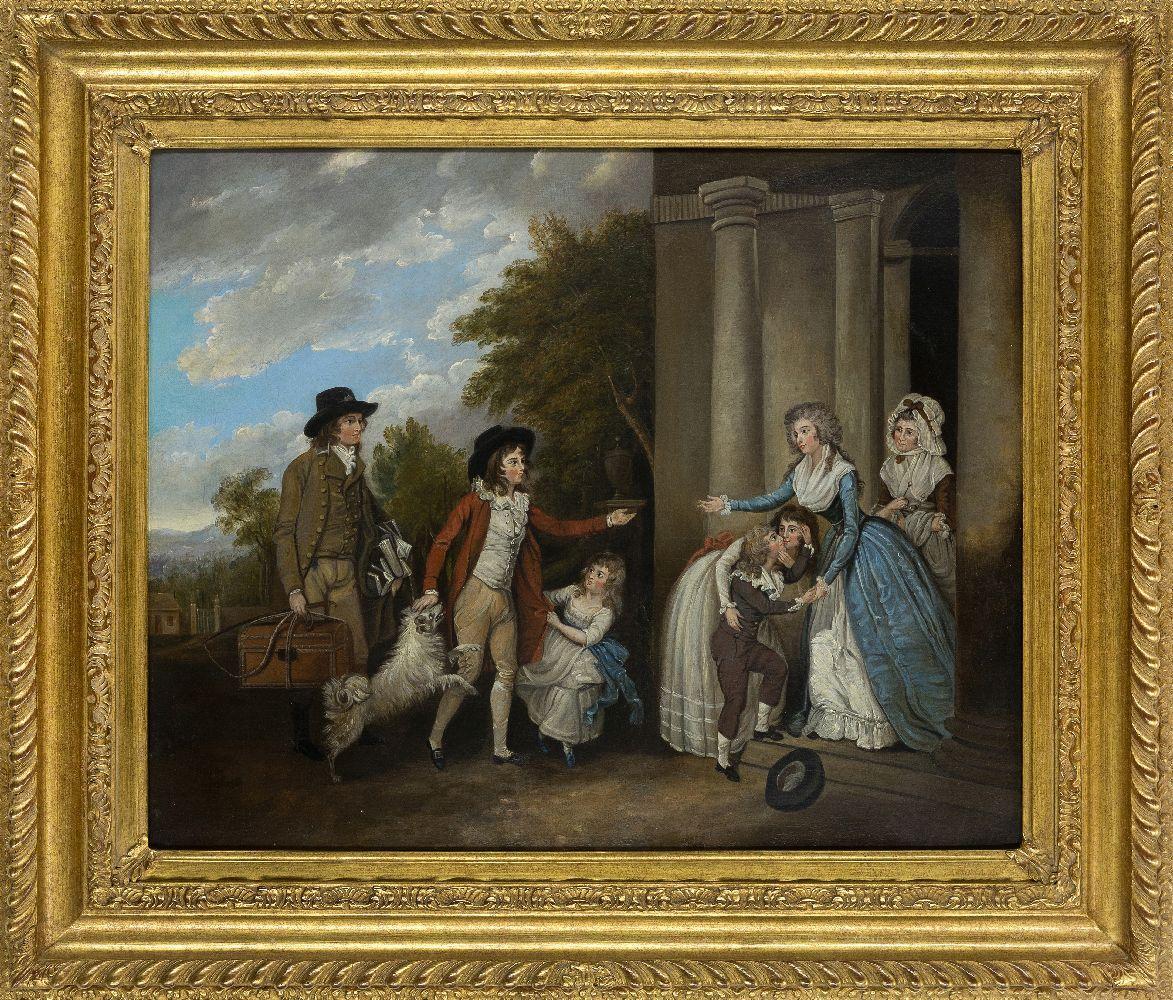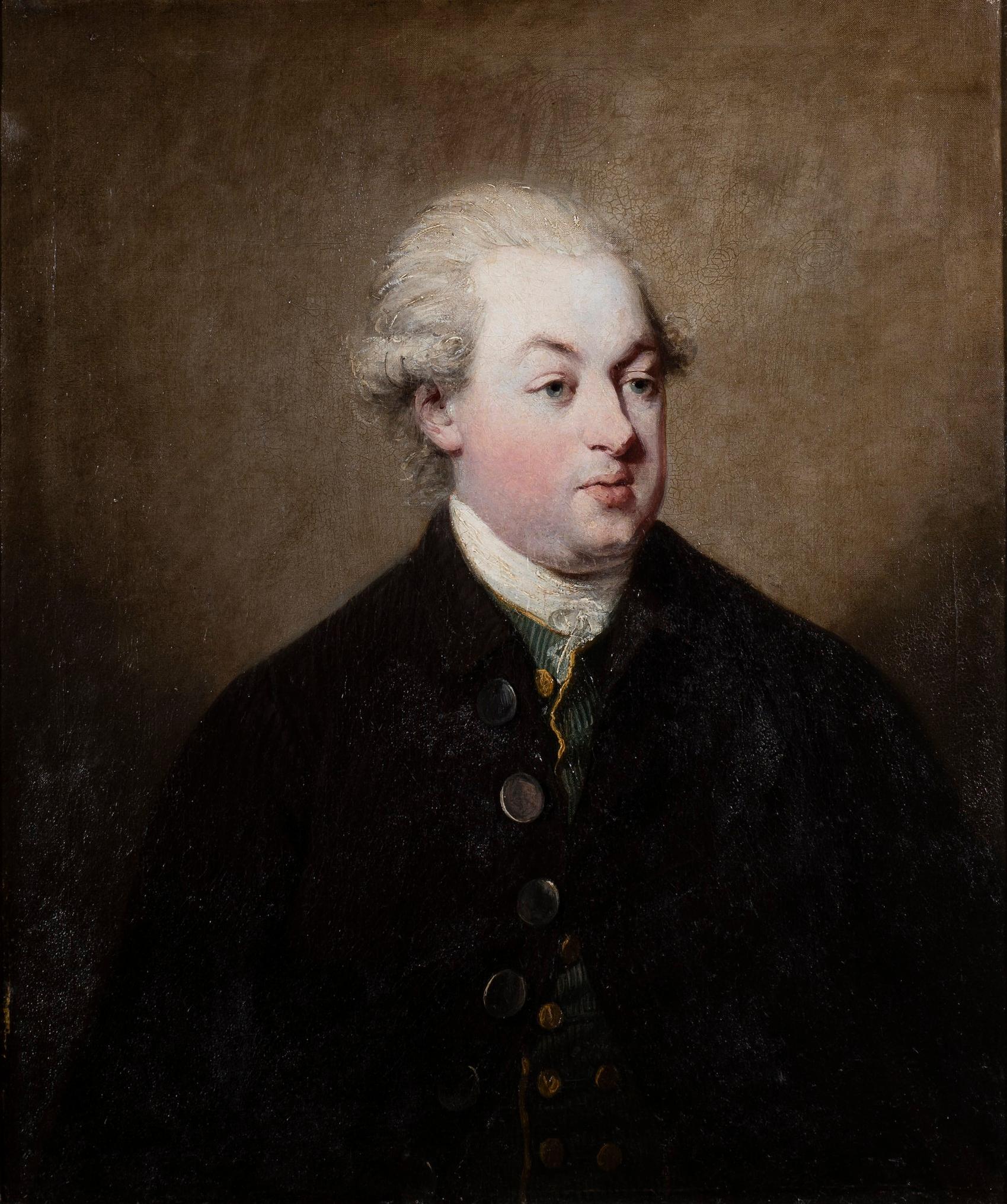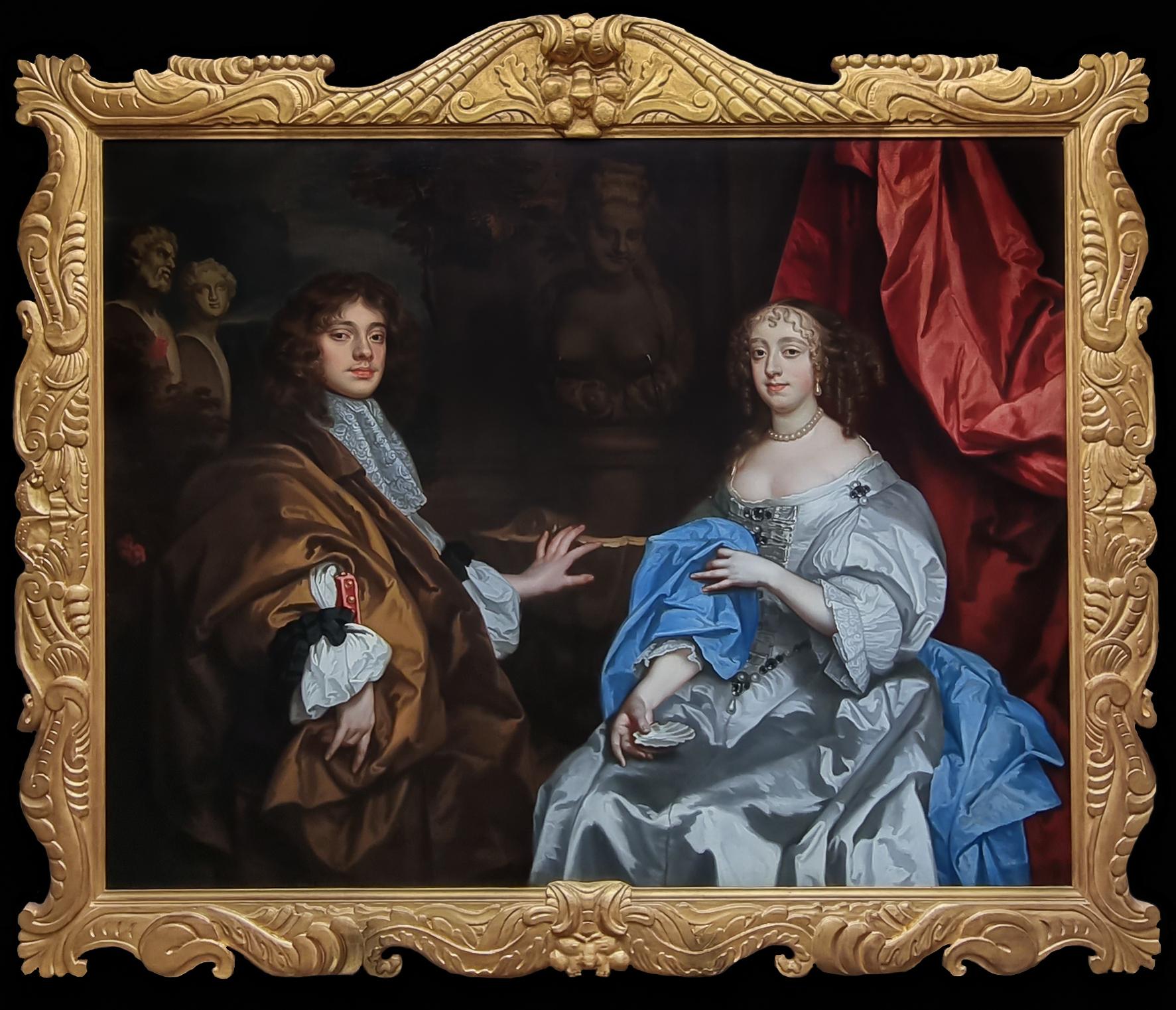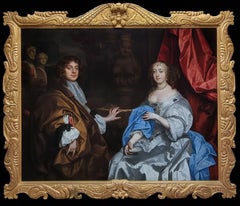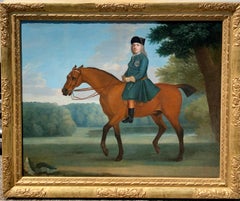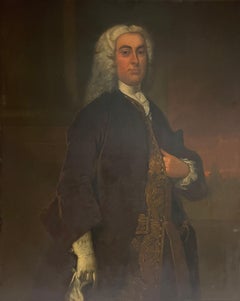
Portrait of a Gentleman
Want more images or videos?
Request additional images or videos from the seller
1 of 9
Portrait of a Gentlemancirca 1740
circa 1740
About the Item
- Creation Year:circa 1740
- Dimensions:Height: 55.91 in (142 cm)Width: 47.25 in (120 cm)Depth: 2.76 in (7 cm)
- Medium:
- Movement & Style:
- Period:
- Condition:
- Gallery Location:London, GB
- Reference Number:1stDibs: LU119914289861
About the Seller
5.0
Platinum Seller
These expertly vetted sellers are 1stDibs' most experienced sellers and are rated highest by our customers.
Established in 1998
1stDibs seller since 2019
31 sales on 1stDibs
More From This SellerView All
- Portrait of Lady, Grace Saunderson, Viscountess Castleton Oil on canvas PaintingBy Studio of Sir Peter LelyLocated in London, GBPortrait of Grace Saunderson, Viscountess Castleton (1635-1667) c.1665-67 Sir Peter Lely and Studio (1618-1680) Titan Fine Art present this work, which formed part of a collection of family pictures and heirlooms of the Saunderson, Viscount Castleton family and their descendants, the Earls of Scarbrough, at their magnificent family seat Sandbeck Park, where the Earls still reside today almost four hundred years later. It was painted in the studio of Sir Peter Lely...Category
17th Century Old Masters Portrait Paintings
MaterialsCanvas, Oil
- Grand-Scale Old Master Garland Portrait, 17th Century, Signed & Dated, Rare workLocated in London, GBIndistinctly signed and dated In the first quarter of the 17th century a new form of flower painting was developed in Flemish painting, which, recreated by a large group of artists and workshops, would achieve considerable success throughout the century in much of Europe: the garland of flowers surrounding a central figure. Brueghel de Velurs was the initiator of this type of composition, however, it was his pupil, Daniel Seghers, who was the dominant figure in this specialised production and the creator of a prototype that would serve as a model for the numerous artists who followed in his wake. It seems undeniable that the artist of the present painting had seen the Garlands of Flowers Surrounding a Medallion Depicting the Triumph of Love by Daniel Seghers and Domenico Zampieri (now in the Musée du Louvre in Paris). In our painting, the present floral wreath encircles a carved cartouche within which sits Saint Dorothy of Caesarea and the attribute which often accompanies her in art, a basket of roses. The extremely delicate flowers have been rendered in meticulous detail, so that every species can be identified from exotic tulips to roses, irises and forget-me-nots; this obvious attention to naturalism is inherited from the Flemish manner. Each flower is so precise and refined that they are an individual study in their own right. The still-lifes are from the hand of Jan Anton van den Baren, with the central figures by another accomplished hand. Van den Baren’s arrangement of flowers would have delighted connoisseurs in both Flanders and in Vienna, where the impossibility of their all blooming at the same time of year would have been understood as a further statement of the wonder and beauty of the divine. Van den Baren worked first in Brussels, where he collaborated with Erasmus Quellinus II for the figures in his works, before moving with Archduke Leopold Wilhelm, his patron, to Vienna in 1656, where he instead worked with fellow Flemish émigré painter Nikolaus van Hoy. The iconography relates to an eighth century legend where she was presented a basket of roses by a child. In addition to the brilliance of his handling of still-lifes Van den Baren played an important art historical role as Director of Archduke Leopold Wilhelm’s Picture Gallery in Vienna, then one of the greatest collections in the world and the core of what was to become the present collection of the Kunsthistorisches Museum, Vienna. Van der Baren compiled an inventory of the collection in 1659, and his predecessor as Director of the Archduke’s Picture Gallery (when it was still housed in Flanders), David Teniers, depicted van der Baren (third from right) in his celebrated Archduke Leopold Willem in his gallery at Brussels, conserved at the Kunsthistorisches Museum. It is a shining example of the Flemish Baroque and is a very rare object indeed, considering there are only 14 paintings accepted as authentic works by this artist. We are grateful to Fred Meijer for confirming the attribution to Johannes Antonius van der Baren. A feature of this painting is its outstanding carved and gilded frame with a plethora of flowers and foliage. Titan Fine ArtCategory
17th Century Old Masters Portrait Paintings
MaterialsCanvas, Oil
- Double Portrait of Sir John Rivers 3rd Baronet of Chafford, and Lady Anne RiversLocated in London, GBThis magnificent grand-scale work, offered by Titan Fine Art, formed part of a collection of family pictures and heirlooms of the Rivers Baronets and their descendants for over 325 years, before it was dispersed by the last in the line in 1988. The work was painted by the most technically proficient painter in England after the death of Van Dyck, and the dominant court painter to Charles II and James, Duke of York, Sir Peter Lely. It is no surprise that for years Lely had no serious rivals, was enormously influential and successful, and one of the country’s most important painters – and his work influenced countless artists over generations. The exquisite carved and gilded auricular frame is an astounding work of art in itself. The sitters in this exquisite double portrait are Sir John Rivers, who succeeded as the 3rd Baronet Chafford in 1657 (c.1638 - c. 1679), and his wife, Lady Anne Hewitt (c.1640-c.1689). They are seated in an outdoor setting beside a fountain modelled as a female figure with water issuing into a scallop-shell. The water, the elaborate sculpted fountain with its scallop-edged bowl, and the open shell in her hand are symbols of fertility - as such they make an appropriate allusion to Lady Anne’s potential as wife and mother, recalling Proverbs, chapter 5, verse 18: “Let thye fountain be blessed, and rejoice in the wife of thye youth”. This reference was realised, as Sir John and Lady Anne produced at least six children; their son George (1665-1734) became 4th Baronet of Chafford. The composition, thus, represents a celebration of marriage and was likely commissioned around the time of the betrothal (the marriage took place 26th Feb 1662 or 1663). The statues in the left margin are 'Youth and 'Old Age' and are a typical form of Memento Mori reminding virile young man that even they will lose their youth and grow old. The Rivers family, originally of Kent, traces its history to Sir Bartholomew Rivers, in the reign of Edward IV. The family included several prominent members including several knights, a Commander in the King's Army, a steward of a ducal estate, a Lord-Mayor of London, and an M.P. John Rivers (c.1659-c.1651) was made 1st Baronet of Chafford in 1622 by King James I. The Chafford estate was the family seat and it remained so until the early 1700s with the death of Sir George Rivers, 4th Baronet (1665–1734), whose sons had all died. The Chafford estate was left to his daughters while the baronetcy passed to nephew John Rivers, 5th Baronet (c. 1718–1743), and then Sir John’s brother, Sir Peter Rivers-Gay, 6th Baronet (c. 1721–1790). Upon Sir Peter Rivers Gay's death the estate passed to his eldest son, Sir Thomas Rivers Gay, 7th Baronet (c. 1770–1805). Sir Thomas, dying in 1805 with no children, bequeathed the estate to his mother Dame Martha Rivers Gay, who managed the estate until 1834 when she settled it on the then Sir Henry Rivers, 9th Baronet (c. 1779–1851) her younger son, before dying shortly thereafter in 1835. Sir Henry had married in 1812 to Charlotte Eales, with whom he had 6 sons and 8 daughters. Upon his death in 1851 the estate passed to his eldest surviving son Sir James Francis Rivers, 10th Baronet (1822–1869). Sir James married Catherine Eastcott in 1867 but died childless in 1869, and the estate passed to his only surviving brother Sir Henry Chandos Rivers, 11th Baronet (1834–1870) but he died a year later in 1870 also childless; with no male heir the Baronetcy was therefore extinguished. The estate was bequeathed, in trust, by Sir Henry Chandos Rivers to Thomas Frederick Inman, a solicitor of Bath, who then managed the estate as a trustee on behalf of Sir Henry Chandos Rivers' sister Katherine Rivers (c.1826-1895). It then passed to Katherine River’s daughter, Katherine Wall (born c.1855), who had also inherited Worthy Park House from her father, George Alfred Ellis Wall (1825-1875). Until 1958 our portrait is known to have hung at Worthy Park House. Upon Katherine Wall’s death, the Rivers estate passed to her daughter, Katherine Eleonora Rivers Fryer (1889-1963), who married Colonel James Alexander Butchart 1877-1853. In 1958 the family sold Worthy Park House but our portrait was loaned to Southampton Museum and Art Gallery. After the death of Katherine and Colonel James, the estate was left to their only son, Charles Bruce Rivers Butchart (1917-2005) and upon Charles’ retirement to a nursing home in 1988, and without heirs, our portrait, along with the residual assets of the Rivers estate were sold, thus ending over 325 years of continual family ownership. Lady Anne Rivers is thought to have been born circa 1640. She was the fourth child of the second marriage of Sir Thomas Hewitt (or Hewett) (1606-1662), 1st Baronet of Pishobury, Herts, and his wife Margaret Lytton (died 1689). Sir Thomas was an English landowner and M.P. for Windsor and upon the English Restoration...Category
17th Century Old Masters Portrait Paintings
MaterialsCanvas, Oil
- Portrait of a Lady, Marie-Madeleine de Chamillart, Oil on Canvas PaintingLocated in London, GBThis work, offered by Titan Fine Art, formed part of the collection of paintings and family heirlooms of Baron Hugues Alfred Frèdéric de Cabrol de Moute (1909-1997) and his wife, Baroness Marguerite (née d’Harcourt) de Cabrol de Moute (1915-2011). The couple had unimpeachable and enviable family backgrounds, and were descendants of ancient princelings; together they were one of the most prominent high-society couples of the twentieth century and counted the Duke of Duchess of Windsor amongst their closest friends. This portrait is that of Marie-Madeleine de Chamillart (died 28 May 1751) nee Nicolas de Lusse. She had a daughter, Anne, in 1692. In 1700 she married Clément Chamillart (1663-1708), President of the Accounts of the King's Chamber. The couple had a daughter, Madeleine (born 1701), who married Louis, the only son of Guillaume de Guitaut and Antoinette de Vertamont in 1719. Guillaume de Guitaut resided at Château d'Époisses in Burgundy France and his descendants still live today. A portrait of our sitter is still held at the Château. Clément Chamillart died in 1708 and our sitter remarried Jean-Baptiste de Johanne de la Carre (1678-1726), marquis de Saumery, maréchal de camp, in 1713. This marriage produced two daughters, Marguerite (died 1729) and Marie Madeleine (born 1720). Much of the beauty of this elegant portrait resides in its graceful composition – it is a fine example of French portraiture. Beautifully and meticulously rendered throughout, the sitter has been depicted three quarter length in an outdoor setting beside a potted orange tree. The lady is shown in a blue dress with silver detailed décolletage and large voluminous sleeves turned over to reveal elaborately detailed lining. The sumptuous fabrics convey a sense of wealth and prestige. The portrait is striking in its portrayal of the sumptuous fabrics and their decorative richness. The prominent sprig of orange blossom that she is holding is a traditional representation of marriage and eternal love in art, but it also alludes to youth and freshness, and by virtue of the great expense and difficulty with which it was often grown, to great wealth. In accordance with the sitter's age and the style of clothing and hair with the curls on the forehead, this portrait can be dated to the 1720s. Baron Hugues Alfred Frèdéric de Cabrol de Moute (1909-1997) was the son of Roger de Cabrol de Moute and Helen Mary de Lassence. He was one of the more engaging personages in that delightful social constellation of social figures who animated what has become known as "Cafe Society" which was international but inevitably most at home in Paris from the 1920's until the 1960's. He married Marguerite d'Harcourt (1915-2011), known as Daisy, in Paris in 1937, the only daughter of Étienne, Marquis d'Harcourt, and his wife, Marie de Curel. The Harcourt family belongs to the circle of the oldest families in France; the founder of the family, Bernard le Danois, received the seigniory of Harcourt in the tenth century, following the conquest of Normandy. In the 11th century, his descendants took part in the conquest of England alongside William the Conqueror. Later, the Harcourt family was divided into a French branch and an English branch, which successively received the titles of barons, viscounts, and counts. Marguerite "Daisy" Marie Brigitte Emmanuelle Ghislaine d'Harcourt, Baronne de Cabrol was one of the last survivors of twentieth century French high society. Through her mother, Daisy was a descendant of the great industrial family of Wendel, with iron and steel enterprises in Lorraine; she also descended from Nicolas Soult, one of Napoleon's Marshals and three times Prime Minister of France. The couple became friends of the Duke and Duchess of Windsor in 1947, and were invited to the Chateau de la Croë, their rented house on Cap d'Antibes. There they found the exiled Windsors living in unusual post-war luxury, serving delicious food and providing fresh sheets every day. Daisy suspected that the Windsors were bored, but, having nothing else to do, were condemned to an endless round of social engagements. She and Fred were among the few allowed to see the Duchess laid out after her death in 1986. Daisy was a considerable hostess, giving a ball every year for her charity, L'Essor, to which le tout Paris would come. One of these, in 1954, was at the Palais des Glaces, in Paris (later used in the film Gigi), at which she entertained Charlie Chaplin, the Begum Aga Khan and the Windsors. According to Nancy Mitford...Category
18th Century Old Masters Portrait Paintings
MaterialsOil, Canvas
- Portrait of an Elegant Lady in a Red Silk Dress, Beautiful Antique Frame c.1720By Jonathan Richardson the ElderLocated in London, GBThis beautiful portrait was painted circa 1725 and is a fine example of the English eighteenth century portrait style. The artist has chosen to depict the lady against a plain background wearing a simple red silk dress and transparent headdress hanging down the back. The sitter is not shown with jewellery or any other elements to distract the viewer’s attached, thus highlighting the beauty of the young sitter. This restrained manner achieves a sense of understated elegance. The portrait genre was valued particularly highly in English society. Neither landscapes nor allegorical pictures were ever priced so highly at exhibitions and in the trade as depictions of people, from the highest aristocracy to scholars, writers, poets and statesmen. With the rich colouring and lyrical characterisation, these works are representative of the archetypal English portrait and is are very appealing examples of British portraiture...Category
18th Century Old Masters Portrait Paintings
MaterialsCanvas, Oil
- Portrait of an Elegant Lady in a Blue Silk Dress, Beautiful Antique Frame c.1720By Jonathan Richardson the ElderLocated in London, GBThis beautiful portrait was painted circa 1725 and is a fine example of the English eighteenth century portrait style. The artist has chosen to depict the lady in a simple blue silk dress and without jewelry or a background, thus allowing the viewer to concentrate solely on the beauty of the sitter. The effect of this restrained manner creates a sense of understated elegance. The portrait genre was valued particularly highly in English society. Neither landscapes nor allegorical pictures were ever priced so highly at exhibitions and in the trade as depictions of people, from the highest aristocracy to scholars, writers, poets and statesmen. With the rich colouring and lyrical characterisation, these works are representative of the archetypal English portrait and is are very appealing examples of British portraiture...Category
18th Century Old Masters Portrait Paintings
MaterialsCanvas, Oil
You May Also LikeView All
- 18th century English portrait of the Duke of Newcastle upon his horse inBy Thomas SpencerLocated in Woodbury, CTThomas Spencer was a leading sporting and equestrian artist of the period of John Wootton and James Seymour; his art shows a considerable to debt to tha...Category
1760s Old Masters Portrait Paintings
MaterialsCanvas, Oil
$54,800 Sale Price20% OffFree Shipping - Huge Antique English Aristocratic Portrait of Baronet, Fine Ancestral PortraitLocated in Cirencester, GloucestershireEnglish School, 18th/ 19th century Portrait of Sir Wolstan Dixie, 4th Baronet *see notes below on sitter oil painting on canvas, unframed 50 x 40 inches condition: the painting is in very satisfactory condition without any damage, tears or punctures to the canvas. It is very original and would benefit from a clean ideally, slight scuffing to the edges of canvas. provenance: private collection, Leicestershire, England * The sitter is Sir Wolstan Dixie (4th Baronet, born 1700). Although the family came from a yeoman family of Huntingdonshire, his ancestor, also Sir Wolstan, made a fortune in the City as a merchant, and served as Lord Mayor of London in 1585-6, Sir Wolstan (the 1st Baronet) acquired the manor of Market Bosworth in west Leicestershire and in 1592, having no children...Category
18th Century Old Masters Figurative Paintings
MaterialsCanvas, Oil
- COUNTRY GIRL- In the Manner of W.A.Bouguereau- Italy Oil on canvas -PaintingBy Pietro ColonnaLocated in Napoli, ITCountry girl - Pietro Colonna Italia 2006 - Oil on canvas cm. 45x25 Gold gilded wooden frame available on request The painting by Pietro Colonna is a reinterpretation of the Young Sh...Category
Early 2000s Old Masters Portrait Paintings
MaterialsCanvas, Oil
- Fine English Georgian Oil Family Welcoming Son back From School Country HouseLocated in Cirencester, Gloucestershire"The Return from School" English School, circa 1820 after the painting by William Redmore Bigg, RA, British 1755-1828 condition: excellent restored condition Provenance: Christie’s, 1988; Private Collection, UK A very fine Georgian painting capturing this wonderful image from the social history of England. We see a school boy returning home for the holidays, his trunk and belongings being handed over, whilst his mother and siblings watch on, on the steps and entrance to their large country home (the gate lodge stands in the distance). It is a superbly painted work and presented in excellent condition. The image is after the original painting by William Redmore Bigg, RA, British 1755-1828. Chiefly known from their many engraved versions, the original oils...Category
Early 19th Century Old Masters Portrait Paintings
MaterialsOil, Canvas
- Portrait of a GentlemanLocated in London, GBPeters was born in Freshwater, Isle of Wight, the son of Matthew Peters (born at Belfast, 1711), a civil engineer and member of the Royal Dublin Society; by Elizabeth, the eldest daughter of George Younge of Dublin. The family moved from England to Dublin when Peters was young, where his father "advised on the improvement of loughs and rivers for navigation" and published two treatises on the subject. Peters received his artistic training from Robert West in Dublin; in 1756 and 1758 he received prizes from the first School of Design in Dublin. In 1759, he was sent by the Dublin Society to London to become a student of Thomas Hudson and won a premium from the Society of Arts. The group also paid for him to travel to Italy to study art from 1761 to 1765. On 23 September 1762 he was elected to the Accademia del Disegno in Florence. Peters returned to England in 1765 and exhibited works at the Society of Artists from 1766 to 1769. Beginning in 1769, Peters exhibited works at the Royal Academy. In 1771 he was elected an associate and in 1777 an academician. He returned to Italy in 1771 and stayed until 1775. He also probably traveled to Paris in 1783–84, where he met Léopold Boilly, Antoine Vestier, and was influenced by the work of Jean-Baptiste Greuze. On 27 February 1769, Peters became a freemason, and he was made the grand portrait painter of the Freemasons and the first provincial grand master of Lincolnshire in 1792. In 1785, he exhibited portraits of the Duke of Manchester...Category
18th Century Old Masters Portrait Paintings
MaterialsOil, Canvas
- 17th century portrait of a ladyBy Nicolaes MaesLocated in Bath, SomersetPortrait of a lady richly dressed in a purple silk gown with white sleeves, a gold coloured cloak draped across one shoulder, her blonde curls worn up...Category
17th Century Old Masters Portrait Paintings
MaterialsCanvas, Oil
Recently Viewed
View AllMore Ways To Browse
Antique Hand Embroidery Patterns
Devotion Satin
Antique Hand Cuffs
Scottish Gentleman
After Hogarth
Dior Shirt Dress
Pink Velvet Coat
Antique Shirt Mens
Waistcoat Dress
Velvet Formal Dresses
Foil Dress
Italian 18th Century Portrait Of A Woman
18th Century Waistcoat
Henry Isaac
Dior Men Coats
Hogarth Oil
Velvet Shirt Dress
Satin Opera Coat

